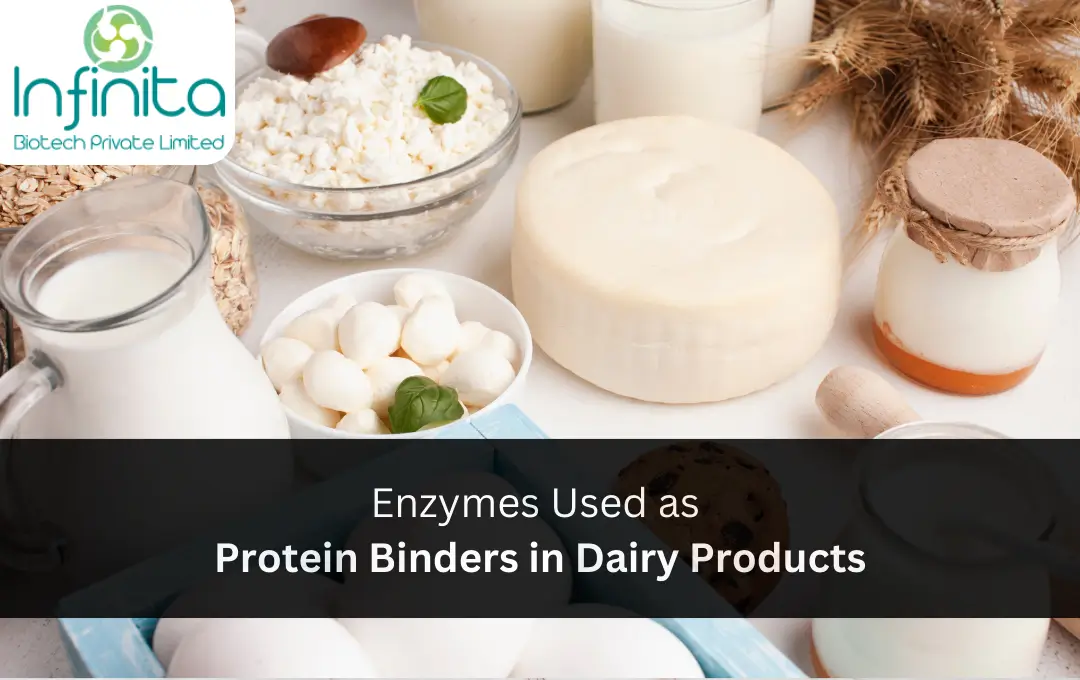In the dairy industry, enzymes play a crucial role in the production of various products. One of the applications of enzymes is their use as protein binders in dairy products. Enzymes are natural proteins that act as catalysts, speeding up chemical reactions within a living organism. Understanding the role of enzymes in dairy products requires examining the science behind their functionality and recognizing their importance in ensuring consistency in dairy product quality.
Understanding the Role of Enzymes in Dairy Products
Enzymes have been used in the dairy industry for centuries, and their significance cannot be overstated. The science behind enzymes as protein binders lies in their ability to break down proteins into smaller peptides and amino acids, resulting in improved functionality and stability in dairy products.
The Science Behind Enzymes as Protein Binders
Enzymes, such as proteases, are responsible for breaking down proteins and releasing bioactive peptides. This breakdown process is crucial for developing dairy products as it enhances their texture, flavor, and overall quality. Enzymes act on specific peptide bonds within proteins, resulting in the formation of smaller peptides with unique functionalities.
For example, in the production of cheese, enzymes play a vital role in the formation of its characteristic texture and taste. During the cheese-making process, enzymes break down the proteins in milk, specifically casein, into smaller peptides. These peptides then interact with calcium ions, forming a network that gives the cheese its structure. The enzymatic breakdown of proteins also contributes to the development of complex flavors in aged cheeses, as the peptides undergo further transformations during the ripening process.
Through the enzymatic hydrolysis of milk proteins, enzymes contribute to the formation of a network that binds water and fat, thereby improving the texture and mouthfeel of dairy products. These enzymes effectively modify the protein structure, resulting in enhanced stability and reduced syneresis in products like cheese and yoghurt.
Importance of Enzymes in Dairy Product Consistency
Consistency is a key attribute in dairy product manufacturing, and enzymes greatly influence its achievement. By controlling the breakdown of proteins, enzymes help maintain a consistent and desirable texture in dairy products. The precise regulation of enzyme activity allows manufacturers to create products with specific properties, ensuring consumer satisfaction.
In addition to texture, enzymes also play a crucial role in the consistency of dairy products by affecting their shelf life. Enzymatic activity can help extend the freshness and stability of products like milk and cream. By breaking down proteins and other components that contribute to spoilage, enzymes help inhibit the growth of spoilage microorganisms, thereby prolonging the product’s shelf life.
Furthermore, enzymes can also contribute to the consistency of dairy products by influencing their viscosity. Viscosity refers to the thickness or flow resistance of a product, and it plays a significant role in consumer perception and product performance. Enzymes can modify the molecular structure of proteins, altering their ability to bind water and affect the product’s viscosity. This allows manufacturers to create dairy products with a desired level of thickness or fluidity, catering to different consumer preferences.
Different Types of Enzymes Used in Dairy Products
Various types of enzymes find applications in the dairy industry. Some of the most common enzymes include rennet enzymes for cheese making and protease enzymes for yogurt production.
Enzymes play a crucial role in the production of dairy products, contributing to the unique characteristics and flavors that consumers enjoy. Apart from rennet enzymes and protease enzymes, lipase enzymes are also utilized in the dairy industry for their ability to enhance the taste and aroma of cheeses.
Rennet Enzymes in Cheese Making
Rennet enzymes, traditionally sourced from the stomach lining of young ruminants, are widely used in cheese making. These enzymes coagulate milk proteins, forming the curd that is then processed further to produce different types of cheese. The addition of rennet enzymes allows manufacturers to precisely control the coagulation process, resulting in a wide range of cheese textures and flavors.
Interestingly, the use of microbial rennet, derived from genetically modified microorganisms, has gained popularity as a vegetarian-friendly alternative to animal-derived rennet. This innovation has provided cheese makers with a sustainable and ethical option while maintaining the quality and taste of traditional cheeses.
Protease Enzymes in Yogurt Production
In yogurt production, protease enzymes are employed to enhance the viscosity and texture of the final product. These enzymes break down proteins into smaller peptides, influencing the structure of the yogurt gel. By modifying the protein structure, protease enzymes improve the creaminess and mouthfeel of yogurt, leading to increased consumer acceptance.
Aside from protease enzymes, lactase enzymes are utilized in the production of lactose-free dairy products to cater to individuals with lactose intolerance. These enzymes help break down lactose into simpler sugars, making dairy products more easily digestible for those with lactose sensitivity.
The Process of Using Enzymes as Protein Binders
Using enzymes as protein binders involves a well-defined process that starts with preparing the dairy product for enzyme addition and continues through the binding process itself.
Enzymes play a crucial role in the food industry, particularly in dairy product manufacturing, where they are utilized as protein binders to enhance product quality. By leveraging the specificity and efficiency of enzymes, manufacturers can achieve the desired textural and functional attributes in their final products.
Preparing the Dairy Product for Enzyme Addition
Before enzyme addition, the dairy product must be formulated to ensure optimal enzyme functionality. Factors such as pH, temperature, and the presence of other ingredients can significantly influence enzyme activity. The product’s composition must be carefully adjusted to create an environment that promotes efficient enzymatic action.
Furthermore, the selection of the appropriate enzyme is crucial in this process. Different enzymes exhibit varying specificities and functionalities, necessitating a tailored approach to enzyme selection based on the desired outcome for the dairy product.
The Binding Process: How Enzymes Work
Once the dairy product is prepared, the enzyme is added at the appropriate stage. Enzymes act by breaking specific peptide bonds within the milk proteins, altering their structure and functionality. This enzymatic hydrolysis allows the formation of a protein network that enhances the product’s texture, stability, and overall quality.
Moreover, the binding process facilitated by enzymes is not only limited to texture enhancement but also contributes to flavor development in dairy products. The breakdown of proteins by enzymes releases peptides and amino acids, which can influence the taste profile of the final product, providing a well-rounded sensory experience for consumers.
Impact of Enzymes on Dairy Product Quality
Enzymes play a significant role in improving the quality of dairy products. They contribute to both texture improvement and flavor enhancement.
Enzymes are remarkable biological catalysts that play a crucial role in the production of dairy products. Beyond their role in texture improvement and flavor enhancement, enzymes also aid in the shelf-life extension of dairy products. By breaking down complex molecules into simpler forms, enzymes help inhibit the growth of spoilage microorganisms, thus prolonging the freshness and quality of dairy products.
Enzymes and Texture Improvement in Dairy Products
Enzymes have a profound impact on the texture of dairy products. By breaking down proteins, enzymes create a stable protein network that binds water and fat, resulting in a desirable texture and reduced syneresis. This texture improvement allows for greater versatility in product applications and enhances the overall sensory experience for consumers.
Moreover, enzymes play a crucial role in controlling crystallization in dairy products such as ice cream. By regulating the size and structure of ice crystals, enzymes help maintain a smooth and creamy texture, preventing the formation of undesirable ice crystals. This meticulous control over texture ensures a delightful mouthfeel and consistency in dairy products.
Enzymes and Flavor Enhancement in Dairy Products
In addition to texture improvement, enzymes also enhance the flavor profiles of dairy products. During the hydrolysis process, enzymes release bioactive peptides and amino acids, which contribute to the development of unique flavors and aromas. The use of enzymes in dairy product manufacturing allows for the production of products with distinct and appealing taste profiles.
Furthermore, enzymes play a vital role in reducing bitterness in dairy products. By breaking down bitter peptides, enzymes help mask unpleasant tastes, resulting in a more palatable product. This bitterness reduction enhances the overall sensory experience, making dairy products Enzymes more enjoyable and appealing to a wider consumer base.
Safety and Regulatory Aspects of Enzyme Use in Dairy Products
While enzymes offer numerous benefits to the dairy industry, their use requires careful consideration of safety and adherence to regulatory guidelines.
Health Implications of Enzyme Consumption
Consuming dairy products that have undergone enzymatic processing is generally safe for the majority of individuals. However, some individuals may be intolerant or allergic to specific enzymes, necessitating the labelling of products to inform consumers of their presence. Manufacturers must ensure that enzyme use complies with health and safety regulations to protect consumer well-being.
Regulatory Guidelines for Enzyme Use in the Dairy Industry
Governmental regulatory bodies, such as the Food and Drug Administration (FDA), establish guidelines and approve the safe use of enzymes in the dairy industry. These regulations ensure that enzymes used in dairy products are appropriate for human consumption and meet specific quality and safety criteria. Compliance with these regulations is essential for both producers and consumers, guaranteeing the integrity and safety of enzyme-utilizing dairy products.
In conclusion, enzymes serve as indispensable protein binders in dairy products. Understanding their role and the science behind their functionality is crucial for dairy manufacturers seeking to improve product consistency and quality. By leveraging different types of enzymes, manufacturers can enhance texture and flavor to satisfy consumer preferences. However, safety considerations and adherence to regulatory guidelines are essential to ensure the well-being of consumers. With careful implementation, enzymes continue to revolutionize the dairy industry, creating products that consistently meet consumer expectations for taste, texture, and overall enjoyment.







